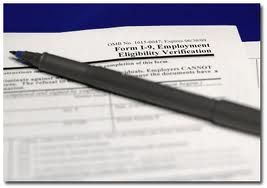
U.S. Immigration and Customs Enforcement (ICE) appears to have launched its latest crackdown on I-9 compliance. While no public announcement has been made, according to reports by attorneys and the Wall Street Journal, ICE inspectors have quietly knocked on the doors of about 1,000 businesses in the past few weeks, handing each a Notice of Inspection (NOI).
Over 3,000 audits last year
While over 3,000 businesses had ICE inspectors appear on their doorstep to present audit notices in 2012, it has been some time since ICE has served a large “wave” of notices like this, all in one fell swoop.
What to expect if they come knocking
As you may know, when you receive a NOI, you have 72 hours to collect the Form I-9s and other records ICE demands. An audit can include any sampling of your workforce, and often includes I-9 records for current employees as well as those terminated within a specified timeframe, across multiple work locations. ICE has broad authority in how it conducts audits, and in some cases has audited an initial set of I-9 records, then later expanded the audit to demand further records.
If you use paper I-9s, brace yourself for a paperwork fine of approximately $555 per record

Here at Tracker we have pretty deep insight into the error rates of legacy I-9 records, since we have an automated I-9 remediation product, Tracker I-9 Resolve. Having processed about a million records so far, we know that on average, 75% of paper I-9s have at least one error.
Using the average error rate, the weighted average of each error type, and the cost of that error type, we’ve been able to calculate that on average, each paper I-9 has a potential liability of $555.
You should also be prepared to clear calendars and dedicate the next 72 hours to responding to the NOI. With paper I-9s, we estimate it takes the equivalent of 5-6 days of labor to prepare your package for each 1,000 records ICE audits. Unfortunately, the more records and work locations included in the audit, or the less tidy your filing system, the bigger the effort to round up all the paperwork that’s required.
What should you do to be prepared for an ICE audit notice?
If you use paper I-9s, you should consider these steps:
- Audit a sample of your existing paper records. This will give you an idea of the compliance level of your historical records.
- Screen a sample of the I-9s your organization creates with the next set of new hires. Since compliance can vary by individual and office, try to screen a sample from each work location. This will give you an idea of your current compliance rate for new hires, and will reveal your most critical training needs.
Based on what you learn from the steps above, you’ll want to initiate training, standardize your I-9 practices, conduct additional audits, and take steps to remediate those I-9 that are found to be out of compliance. Unless your process calls for someone to double-check each I-9 immediately after it is created (and also each reverification), what you will likely discover is your error rate on both historical records and newly-created records is pretty close to the 75% cross-industry average.
With paper I-9s, the only way to improve your compliance levels is to increase the amount of time you put into I-9 processing, including screening and correcting each new I-9 as it is created. Tracker’s I-9 & E-Verify Calculator shows that in order to achieve high compliance with paper I-9s, an organization has to devote 107 minutes of labor for every new employee it hires. For many organizations, devoting this level of resources is simply not feasible.
So, once you determine your actual compliance levels, you might ask how important it is to increase those compliance levels. If it’s important, you can solve the problem by increasing your manual efforts or implementing an electronic I-9 system. You want to ensure that the system you select provides complete compliance for all new hires, and allows you to easily remediate your existing records without specialists or excessive labor. For guidance on the key capabilities to look for, read our free whitepaper: 5 Most Critical Requirements for I-9 Automation.
Disclaimer: The content of this post does not constitute direct legal advice and is designed for informational purposes only. Information provided through this website should never replace the need for involving informed counsel on your employment and immigration issues.
Discover how Tracker’s electronic I-9 software service lets you produce flawless I-9s every time. Feel free to contact us we’d love to hear from you.